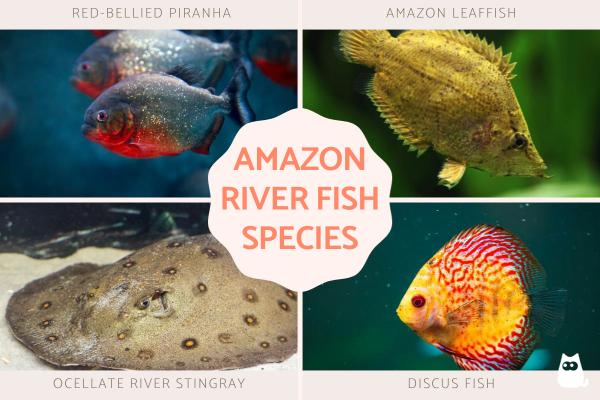
The Amazon River basin is the vast area which covers the river itself and all its tributaries. It is the largest river basin in the world, being home to the greatest diversity of fish species found in a single freshwater system. This diversity extends to approximately 7,000 individual species with an estimated 1,000 more yet to be classified. This ichthyofauna exhibits unique adaptations, the result of long evolutionary processes. Ranging from tiny fish resembling tree leaves to giant beasts measuring over 10 ft, the Amazon is home to extraordinary fish species with unique characteristics.
We share some emblematic species with our AnimalWised list of 10 fish of the Amazon River. In addition to providing details of their characteristics and behaviors, we provide photos so you can get a better idea of their physical diversity for yourself.
Arapaima (Arapaima gigas)
The first on our list of Amazonian fish is the Arapaima, also known as the paiche or pirarucu. It is quite appropriate that they live in the largest river in the world since they are one of the largest freshwater fish in nature. They measure up to 10 ft (3 m) in length and can weigh as much as 440 lb (200 kg). This prehistoric monster can breathe air thanks to its modified swim bladder, allowing it to survive in low-oxygen waters.
Although not dangerous to humans, its size makes it a dominant predator. It feeds on smaller fish and even waterfowl. It is currently in danger of extinction due to overfishing and is protected in several areas of Peru, Brazil and Colombia.
See where the Arapaima places on the list of the 10 largest fish in the world.
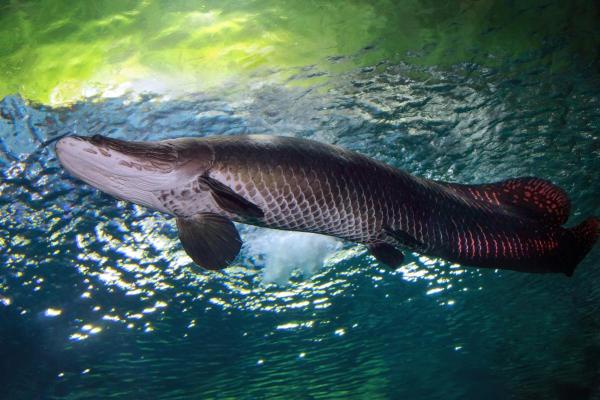
Red-bellied piranha (Pygocentrus nattereri)
This species of piranha is one of the most famous in the Amazon, known for its sharp teeth and very active social behavior. Although they rarely attack humans, in packs they can devour large animals in a short time. Also known simply as the red piranha, their bite has a force of 72 PSI (more than that of a caiman).
They feed primarily on sick or injured fish, fulfilling an important ecological role as river cleaners. During the dry season, the waters recede and they become more dangerous due to competition for food.
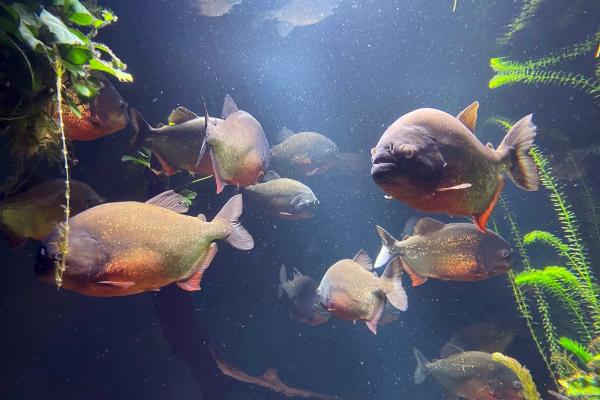
Candiru (Vandellia cirrhosa)
We might correctly associate catfish with cleaning their environment by feeding on detritus, but there is a small subfamily (Vandelliinae) which is known for a completely different diet. The candiru is also known as the vampire fish due to parasitizing the blood of other fish. They do so by attaching themselves to gills with their sharp teeth and feeding until they become inflated with blood. They do not usually cause serious harm to their host.
Another name for the candiru is the toothpick fish. This is because its size is very small and its thin body is elongated like a toothpick. This has led to many stories of candiru entering the urethra of humans and feeding on the blood of their genitals. While gory stories abound, evidence of this happening is scant and some question to veracity of accounts. They live in turbid waters and their translucent bodies make them difficult to see in the water. Blood can sometimes be seen in their bodies after feeding.
Discover other hematophagous animals with our article on animals that eat blood.
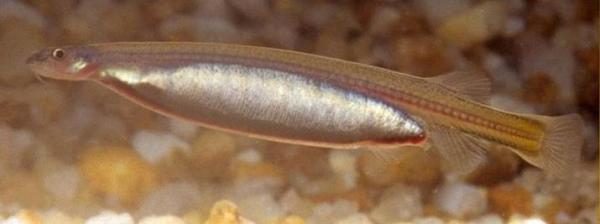
Amazon leaffish (Monocirrhus polyacanthus)
Our next fish of the Amazon River is a master of aquatic camouflage. The Amazon leaffish is a small predator that perfectly mimics a dead leaf, from its body shape to its oscillating motion (0.2-0.5 Hz) which is synchronized with the current. It can dynamically change its pigmentation to match different types of vegetation.
Its attack is one of the fastest in the aquatic world. It expands its mouth in 0.15 milliseconds, generating a negative pressure of 8 kPa. To complete its disguise, it secretes mucus with tannins that simulate the smell of rotting leaves. It only lives in sewage tributaries where visibility is less than 1%.
The leaffish is not the only animal which can hide in plain sight. Our article on the difference between camouflage and mimicry explains more.
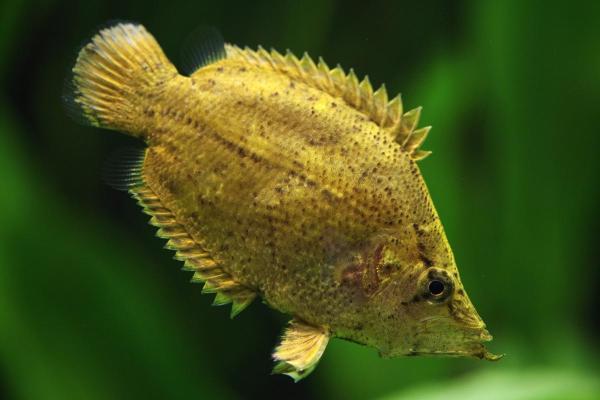
Payara (Hydrolycus armatus)
Also known as the harm, the Payara is a large predatory fish known for its long 6" (15 cm) fangs which protrude from its lower jaw. These teeth are so long that it has special cavities in its skull to house them when it closes its mouth.
It hunts fish larger than itself, using their fangs to pierce their flesh and kill. It can reach nearly 4 ft (1.2 m) and is highly sought after by sport fishermen for its ferocious combat. It lives in rapids and waterfalls in the upper Amazon basin. Some are even kept in aquariums, although they require a very large tank.
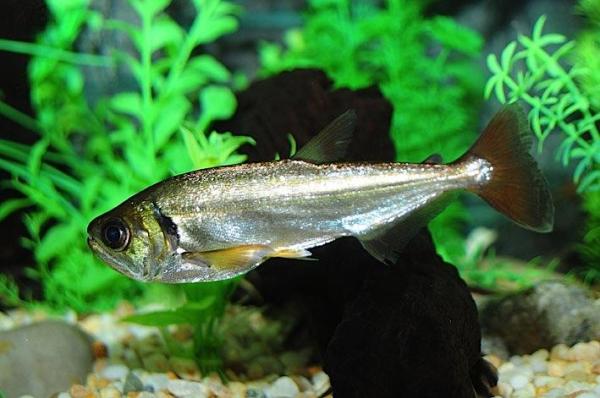
Giant catfish (Brachyplatystoma filamentosum)
Another of the most iconic Amazon Rive fish is the giant catfish known locally as piraíba, lau lau or kumakuma. This catfish grows to over 11 ft (3.5 m) and weighs 440 lb (200 kg), making it the king of the Amazonian catfish. With sensory whiskers that measure up to a meter in elgnth on their own, it detects vibrations in murky waters. It undertakes the longest freshwater migrations to spawn, traveling up to 6,835 miles (11,000 km) to spawn.
Its enormous mouth can swallow prey the dimensions of a medium-sized dog. Although it doesn't attack humans, its size inspires legends about river monsters. It is threatened by dams that block its migratory routes.
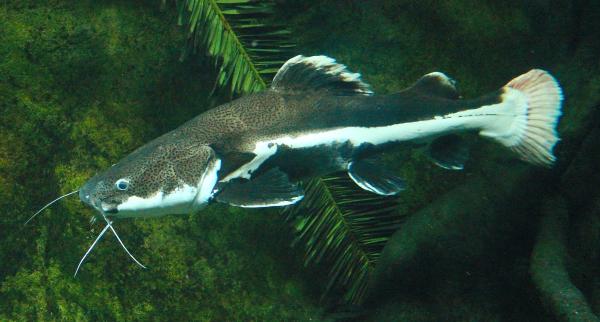
Ocellate river stingray (Potamotrygon motoro)
We might associate stingrays with marine environments, but there are freshwater stingrays in nature. They tend to be found in tropical and subtropical river systems, mainly in South America, but also in some parts of Africa. These Amazon River rays have a venomous stinger on their tail that can cause extreme pain and even death if it hits vital organs. The largest ones measure 5 ft (1.5 m) in diameter and weigh 220 lb (100 kg).
They burrow into the sandy riverbed to ambush fish and crustaceans. Their venom contains tissue-destroying toxins, making them especially dangerous for fishermen who accidentally step on them. They are viviparous animals and give birth to fully formed young.
Learn about the diversity of these fish with our article discussing the different types of stingrays.
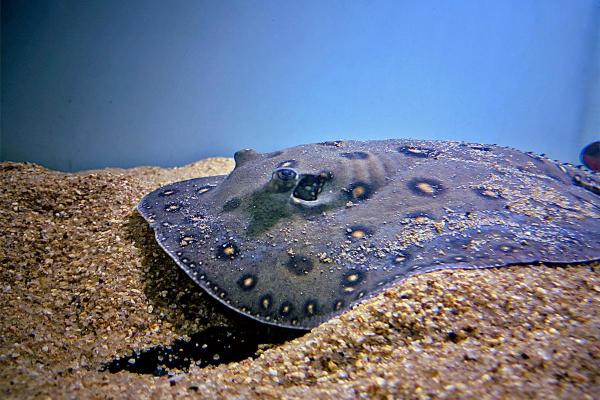
Oscar (Astronotus ocellatus)
Well-known in aquariums, this type of cichlid fish grows up to 20" (50 cm) in the wild and displays surprising intelligence. They recognize their owners in captivity and can even learn tricks.
In the Amazon River, they hunt other fish, crustaceans and even small mammals that fall into the water. Their color pattern changes depending on their mood, resulting in other common names such as the tiger oscar, marble cichlid and velvet cichlid. Indigenous peoples used them as food, but today they are more valued as ornamental fish. They build nests and fiercely guard their young.
Learn more about the oscar fish's diet with our list of the different fish that eat snails.
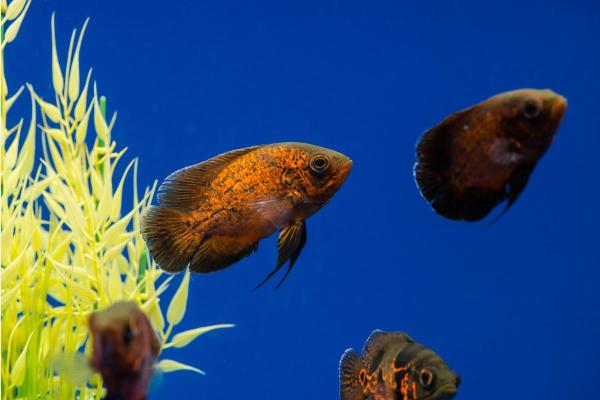
Emerald catfish (Corydoras splendens)
This small armored carnivore has chitinous skin plates that resist piranha bites. It is the only known fish that can breathe through its hindgut when oxygen is scarce. It communicates using 1-5 kHz sounds produced by rubbing its pectoral spines together.
They form trains of more than 100 individuals that scavenge the substrate in search of food. During courtship, the female collects sperm in her mouth to fertilize the eggs, which she then deposits between her pelvic fins in a "T" position.

Discus fish (Symphysodon discus)
Also known as the red discus, this is considered one of the most prized Amazon River fish and one of the world's most iconic freshwater fish. Its circular and laterally compressed body reaches up to 8" (20 cm) in diameter. They feature a dazzling array of colors and patterns that vary depending on its geographic location in the Amazon basin.
They produce a nutritious mucus (composed of 48% protein and lipids) on their skin, which their fry feed on for the first 4 weeks of life. This is the longest period of parental care among tropical fish. Females prefer males with nine or more vertical body bars, an indicator of genetic health and territorial defense ability. There are 15 recognized ecotypes, such as the Heckel (with a distinctive dark fifth bar) and the Brown Discus, each adapted to specific pH and temperature conditions.
Now that you know some of the most important Amazonian river fish, you might want to learn more about the great diversity of this river basin with our article sharing 10 exotic birds of the Amazon Rainforest.
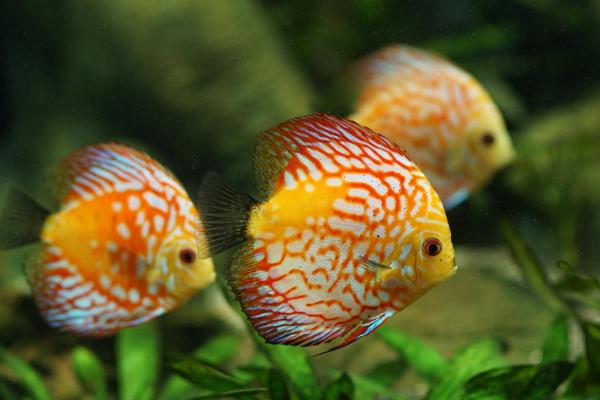
If you want to read similar articles to Fish of the Amazon River, we recommend you visit our Facts about the animal kingdom category.
- Dagosta, F. C., & De Pinna, M. (2019). The fishes of the Amazon: distribution and biogeographical patterns, with a comprehensive list of species. Bulletin of the American Museum of Natural History, 2019(431), 1-163.
- Jézéquel, C., Tedesco, P. A., Bigorne, R., Maldonado-Ocampo, J. A., Ortega, H., Hidalgo, M., ... & Oberdorff, T. (2020). A database of freshwater fish species of the Amazon Basin. Scientific data, 7(1), 96.
- Junk, W. J., Soares, M. G. M., & Bayley, P. B. (2007). Freshwater fishes of the Amazon River basin: their biodiversity, fisheries, and habitats. Aquatic Ecosystem Health & Management, 10(2), 153-173.
- Thatcher, V. E. (2006). Amazon fish parasites (Vol. 1). Pensoft Publishers.
- Val, A. L., & de Almeida-Val, V. M. (2012). Fishes of the Amazon and their environment: physiological and biochemical aspects (Vol. 32). Springer Science & Business Media.